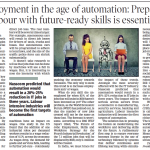Preparing labour with superior future-ready skills is essential.
 The growth of technologies like Artificial Intelligence (AI) and automation is resulting in a better, safer and more efficient world. Investments in automation are pouring in. McKinsey estimates that tech giants worldwide spent anywhere between USD20 billion and USD30 billion on AI in 2016. Interestingly, one of the key drivers of these spends is the falling cost of capital. The unit cost of capital has dropped to less than 0.6 times the unit cost of labour. This amounts to a 16x drop from the unit cost of labour in the early 1980s. This imbalance is flooding research in AI and robotics with money. These technologies will rewrite the practices that dominate global competition, wealth generation and employment. Already the warning bells in job markets are ringing. By 2033, says one World Bank Development Report, automation will put 47% of the current jobs in the US at risk. The corresponding figures for other nations vary. For example, they are 77% for China, 69% for India and 65% for Argentina.
The growth of technologies like Artificial Intelligence (AI) and automation is resulting in a better, safer and more efficient world. Investments in automation are pouring in. McKinsey estimates that tech giants worldwide spent anywhere between USD20 billion and USD30 billion on AI in 2016. Interestingly, one of the key drivers of these spends is the falling cost of capital. The unit cost of capital has dropped to less than 0.6 times the unit cost of labour. This amounts to a 16x drop from the unit cost of labour in the early 1980s. This imbalance is flooding research in AI and robotics with money. These technologies will rewrite the practices that dominate global competition, wealth generation and employment. Already the warning bells in job markets are ringing. By 2033, says one World Bank Development Report, automation will put 47% of the current jobs in the US at risk. The corresponding figures for other nations vary. For example, they are 77% for China, 69% for India and 65% for Argentina.
These estimates are for direct job loss. The real numbers will be several times larger. For example, autonomous cars will result in direct job losses for drivers of taxis, trucks and buses. But autonomous cars will be programmed to adhere to local laws, and the implication of this will be on the size of the traffic police force that may need to shrink substantially. With autonomous cars around the corner, the urgency with which drivers and traffic police will need to be retrained for new jobs will become stronger with every passing day.
There is parallel job loss due to weakening demand for labour. It doesn’t take research to tell us that jobs that can be done by machines will see a fall in wages. But, it is interesting to note the intensity with which machines have an impact on wages. One study in the US found that the addition of one industrial robot per thousand workers results in a wage reduction of 0.5% across the economy. As wages drop, the demand for goods and services falls, leading to further job cuts—relentlessly pushing the economy towards recession. The only way to stem this trend is to increase employment and/ or wages.
What do you skill the unemployed for when 85% of the jobs that will exist in 2030 haven’t been invented as yet? The other problem, as the World Economic Forum has pointed out, is that the number of new jobs created will not be the same as those lost. The forecast is worrisome. According to a 2016 World Economic Forum report titled, “The Future of Jobs: Employment, Skills and Workforce Strategy for the Fourth Industrial Revolution”, of the 7.1 million jobs that will be displaced by 2020, only 2.1 million will be created.
In India, we must brace for the impact of these trends. Amongst the most severely affected will be the IT industry. NASSCOM, the industry body which provides strategic direction to Indian IT, predicted that automation would result in a 20% to 25% reduction in jobs in the IT industry over the next three years. Other industries won’t stay unaffected. The impact will be serious across sectors, from e-commerce to manufacturing, security services, banking and agriculture. Industries that are labour intensive will become the first targets of automation.
The solution lies in pressing the button on modernizing the workforce and delivering skills for the future. A rudimentary first step is to ensure everyone becomes literate in the use of technology followed by systems that deliver continuous and lifelong learning while simultaneously encouraging a culture of being versatile and adaptable. In addition, the process of job destruction and new job creation will be stressful and chaotic making it essential to put in place the mechanisms that make job transitions smoother.
Among the strategies to adopt is altering the tax structures in a bid to prevent the concentration of capital in the hands of the corporations that save on employment costs. This tax can be channelled into employment creation or social security programs. It is also worth examining the idea of taxing robots that replace humans. Bill Gates had suggested this in early 2017 saying that the tax could be used to fund certain types of employment such as those which take care of the elderly or those working with children.
We may even see higher acceptance for the concept of a Universal Basic Income (UBI) that has been around for years. UBI puts money – or what is called ‘guaranteed liveable income’ — into the hands of all citizens, no questions asked. The idea is to create an equitable world. If that happens, surely automation will have played its part in changing society. Meanwhile, a more practical approach is to set up effective strategies for skilling.
Atul Raja is Executive Vice President at Wadhwani Foundation

